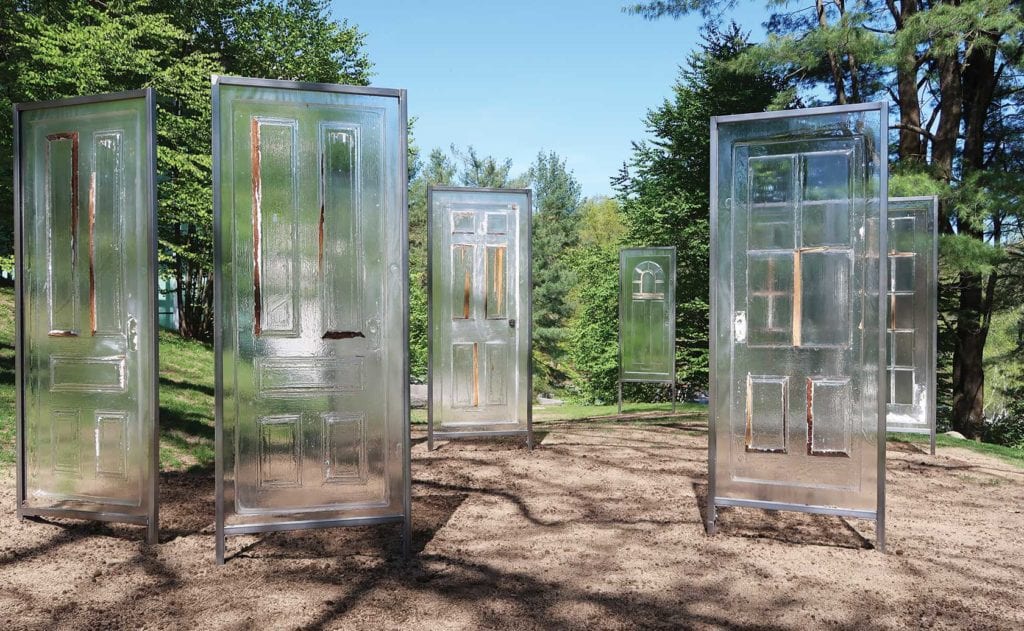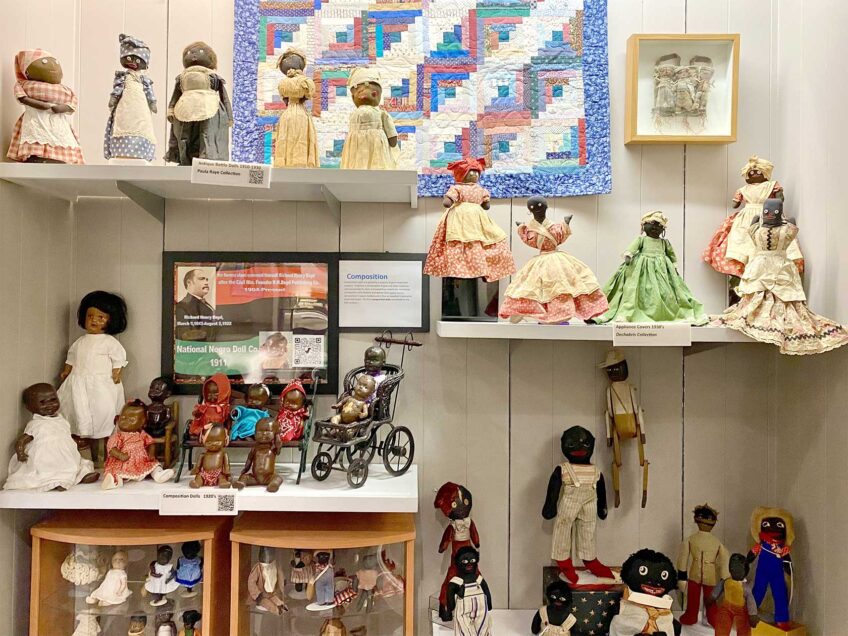
Goats are prized in Jamaica. Their meat is a staple in Jamaican cuisine and goat farming is a proud local industry.
Artist Nari Ward, born in Jamaica and living in Brooklyn, brings elements of his homeland — including goats — into his installations, which confront social inequities with wry wit and imagination. Three of his life-size concrete casts of goats are in residence through July 1, 2019 at the deCordova Sculpture Park and Museum in Lincoln, Massachusetts.

Nari Ward, “Shoe tips with libation, G.O.A.T.” (2017) photos: Susan Saccoccia
Last year, Ward introduced the goats as part of an expansive outdoor installation at Socrates Sculpture Park, in Queens, New York. There, they functioned as lawn ornaments, ironic symbols of excess and waste. He labeled them with the acronym G.O.A.T., which stood for “Greatest of All Time,” an allusion to the hype associated with icons of sports and music. “I really wanted to talk about power and about hubris, about a kind of misguided investment,” Ward says. “This goat character kind of became my doorway into it.”
Ward’s sculpted goats are a tribute of sorts to a humble, valued animal that is a source of food, a hard-working pack animal and an agile, daring climber. The trio at the deCordova stands on a grassy slope overlooking Sandy Pond. Their beguiling, gentle faces are smeared in paint, and plastic jewels shine in their foreheads.
Ward has burdened each goat with urban debris. Spikes of rebar extend from their backs, which bear tall spires of such cast-off objects as a fire hose, shoe tips, and modem cords. In Jamaica, Ward has explained, rebar often protrudes from the rooftops of houses, so floors can be added to make room for a growing family. Somewhat comical and bizarre, Ward’s fusion of rural and urban images evokes other odd juxtapositions in society, such as between haves and have-nots and insiders and outsiders.
Entrances and exits

Nari Ward, “Social Media II, G.O.A.T.” (2017) photos: Susan Saccoccia
On view on a nearby hill is an installation by another Brooklyn-based artist who fashions familiar objects of daily life into new forms that conjure realities beyond what meets the eye.
Saul Melman’s “Best Of All Possible Worlds” (2018), a commission for the deCordova’s PLATFORM series of site-specific works, is a cluster of eight vacuum-molded casts made from the doors in his apartment. The group of translucent plastic replicas stands Stonehenge-like on the top of a hill. The artist has arranged the casts in the same locations that the doors occupy in his home, and he sited the installation along an east-west axis to capture the light of sunrise and sunset.

Nari Ward, “Firehose with libation II, G.O.A.T.” (2017); photos: Susan Saccoccia
An emergency room physician, Melman often creates works that explore transitions between states, such as between life and death. Here, his semi-transparent doors evoke entrances and exits of all kinds. His installation mingles the natural — sunlight in its moment-to-moment mutations — with the fixed material of his casts, which change with the light while remaining immobile objects. And mingling the physical and the ethereal, the installation, when viewed from a distance, appears to hover on the grassy knoll.
Glinting in the sun, the translucent replicas are objects of interest in themselves and reward a closer look. Traces of paint and wood suggest the wear of daily life. One cast with gilded edges and elegant curved lines, evokes the old-world charm of the original door. Others are a set of rectangles, like found works of abstraction.
Plenty more awaits visitors to the deCordova, a 35-acre sculpture park with more than 60 works as well as a contemporary art museum. Among the sculptures near the installations by Ward and Melman are Roxbury-born John Wilson’s 1987 study for “Eternal Presence” (aka “Big Head”), the seven-foot high sculpture that stands at the National Center for Afro-American Artists in Boston; and DeWitt Godfrey’s “Lincoln” (2012), a row of giant steel loops that tumbles down a hill.
On June 21, the summer solstice, Melman will join visitors at the site of his work to observe the end of the longest day in the year. If the weather is clear, the setting sun will set his installation ablaze.


![Banner [Virtual] Art Gallery](https://baystatebanner.com/wp-content/uploads/2024/04/Cagen-Luse_Men-at-store-e1713991226112-150x150.jpg)

![Banner [Virtual] Art Gallery](https://baystatebanner.com/wp-content/uploads/2024/04/Cagen-Luse_Men-at-store-e1713991226112-848x569.jpg)

